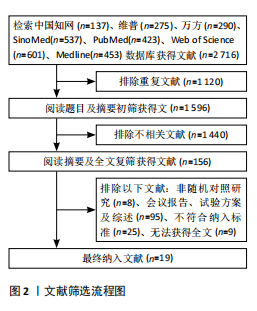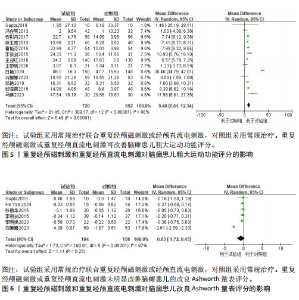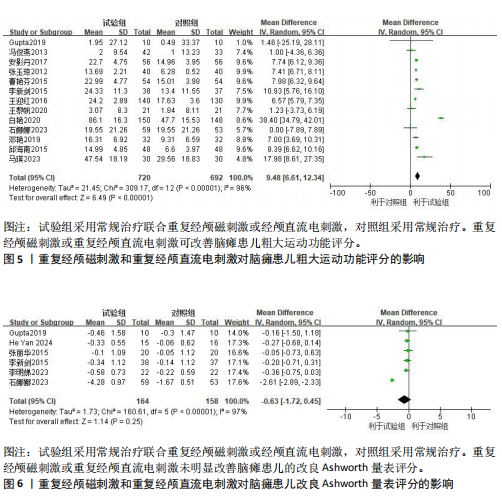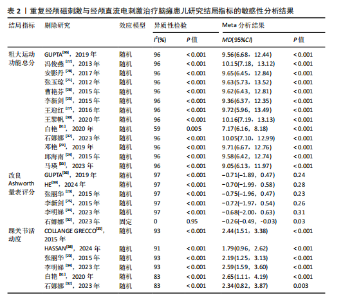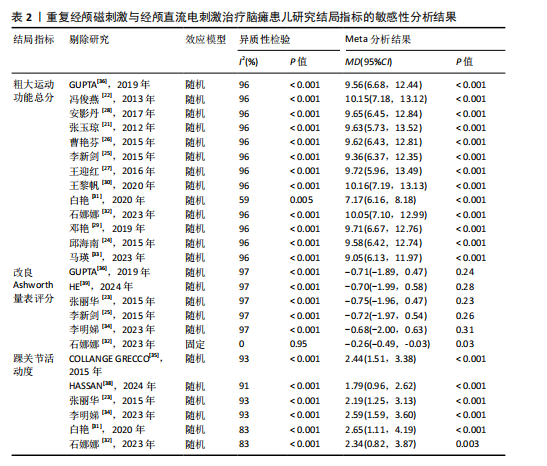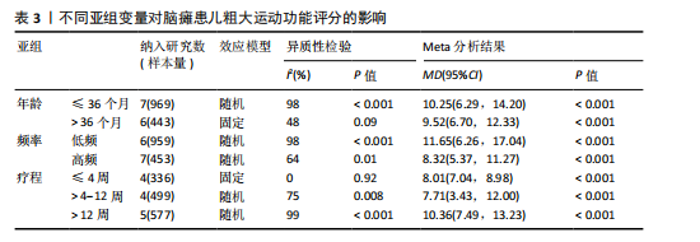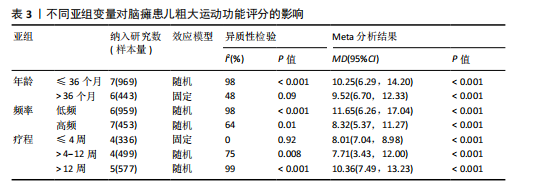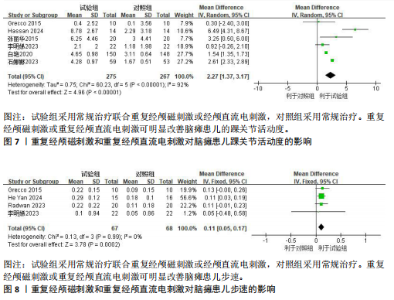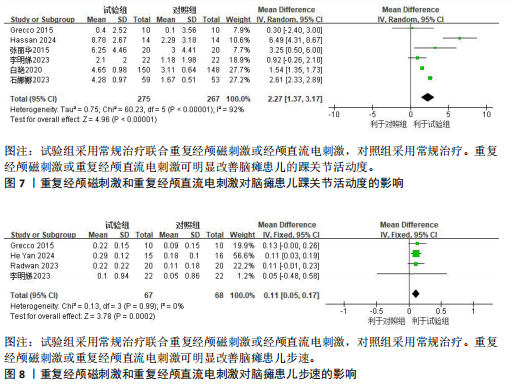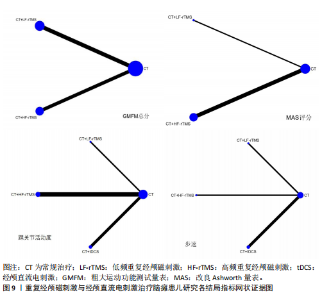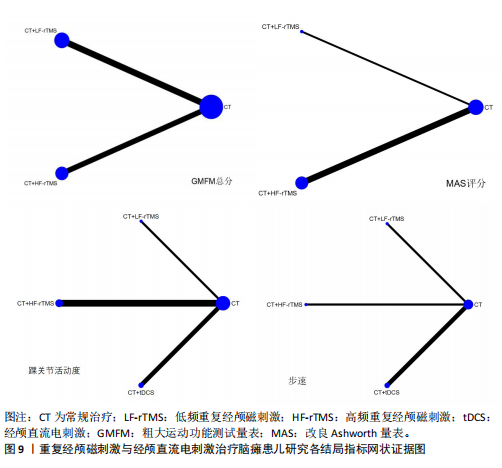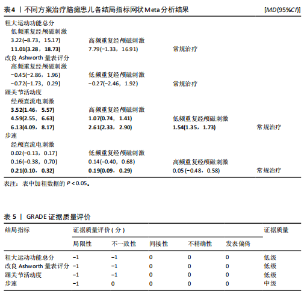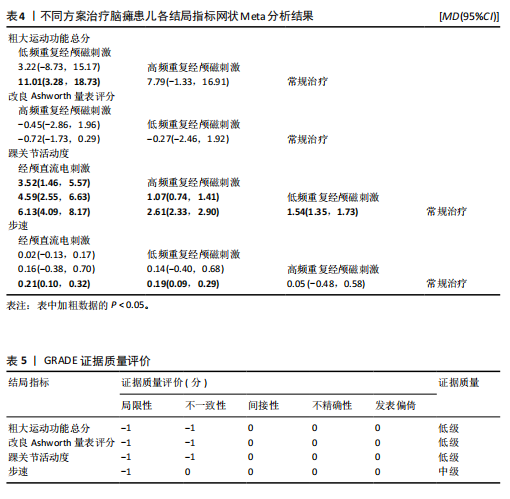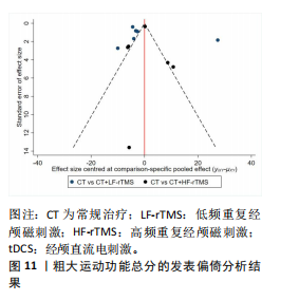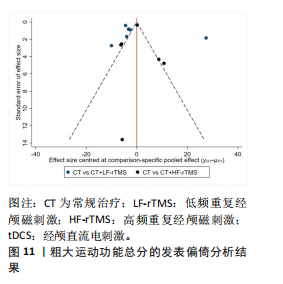Chinese Journal of Tissue Engineering Research ›› 2026, Vol. 30 ›› Issue (6): 1539-1548.doi: 10.12307/2026.574
Previous Articles Next Articles
Effect of repetitive transcranial magnetic stimulation and transcranial direct current stimulation on motor function and gait in children with cerebral palsy: a network meta-analysis
Cao Xinyan1, Yu Zifu2, Leng Xiaoxuan1, Gao Shiai1, Chen Jinhui1, Liu Xihua3
- 1School of Rehabilitation Medicine, Shandong University of Traditional Chinese Medicine, Jinan 250355, Shandong Province, China; 2Shandong Province Center for Disease Control and Prevention, Jinan 250014, Shandong Province, China; 3Department of Rehabilitation, Affiliated Hospital of Shandong University of Traditional Chinese Medicine, Jinan 250011, Shandong Province, China
-
Received:2024-12-23Accepted:2025-02-20Online:2026-02-28Published:2025-07-18 -
Contact:Liu Xihua, Associate chief physician, Department of Rehabilitation, Affiliated Hospital of Shandong University of Traditional Chinese Medicine, Jinan 250011, Shandong Province, China -
About author:Cao Xinyan, Master candidate, School of Rehabilitation Medicine, Shandong University of Traditional Chinese Medicine, Jinan 250355, Shandong Province, China -
Supported by:Shandong Province Traditional Chinese Medicine Technical Project, No. M-2023142 (to LXH); Shandong Province Medical Workers Science and Technology Innovation Plan Project, No. SDYWZGKCJH2022024 (to LXH)
CLC Number:
Cite this article
Cao Xinyan, Yu Zifu, Leng Xiaoxuan, Gao Shiai, Chen Jinhui, Liu Xihua. Effect of repetitive transcranial magnetic stimulation and transcranial direct current stimulation on motor function and gait in children with cerebral palsy: a network meta-analysis[J]. Chinese Journal of Tissue Engineering Research, 2026, 30(6): 1539-1548.
share this article
Add to citation manager EndNote|Reference Manager|ProCite|BibTeX|RefWorks
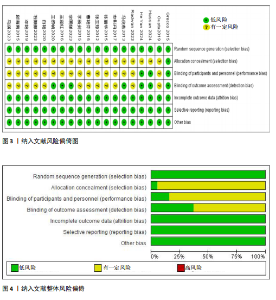
2.2 纳入文献的基本特征 共纳入19篇研究,共1 615例脑瘫患儿,其中对照组794例、试验组821例,涉及4种治疗方案,分别为常规治疗、高频重复经颅磁刺激、低频重复经颅磁刺激、阳极经颅直流电刺激,见表1。 2.3 文献质量评价 纳入的19篇文献均报道了随机分组方法(包括随机数字表法、区组随机分组),1篇文献提到分配隐藏(不透明信封法)[35],7篇文献对患者或评估人员施盲[22,27,30,34-35,38-39]。所有文章结果数据完整,无选择性报告,并且均未提到其他偏倚来源,见图3,4。 2.4 传统Meta分析结果 2.4.1 粗大运动功能评分 共纳入13篇研究[21-22,24-33,36],涉及1 412例患者,其中对照组692例、试验组720例。Meta分析结果显示,各研究间存在明显异质性(I2=96%,P < 0.000 01),采用随机效应模型,重复经颅磁刺激或重复经颅直流电刺激可改善脑瘫患儿粗大运动功能评分[MD=9.48,95%CI(6.61,12.34),P < 0.000 01],见图5。 2.4.2 改良Ashworth量表评分 共纳入6篇研究[23,25,32,34,36,39],涉及322例患者,其中对照组158例、试验组164例。Meta分析结果显示各研究间存在明显异质性(I2=97%,P < 0.000 01),采用随机效应模型,重复经颅磁刺激或重复经颅直流电刺激未明显改善脑瘫患儿改良Ashworth量表评分[MD=-0.63,95%CI(-1.72,0.45),P=0.25],见图6。 2.4.3 踝关节活动度 共纳入6篇研究[23,31-32,34-35,38],涉及542例患者,其中对照组267例、试验组275例。Meta分析结果显示各研究间存在明显异质性(I2=92%,P < 0.000 01),采用随机效应模型,重复经颅磁刺激或重复经颅直流电刺激可明显改善脑瘫患儿踝关节活动度[MD=2.27,95%CI(1.37,3.17),P < 0.001],见图7。 2.4.4 步速 共纳入4篇研究[34-35,37,39],涉及135例患者,其中对照组68例、试验组67例。Meta分析结果显示各研究间不存在异质性(I2=0%,P=0.99),采用固定效应模型,重复经颅磁刺激或重复经颅直流电刺激可明显改善脑瘫患儿步速[MD=0.11,95%CI(0.05,0.17),P=0.000 2],见图8。"
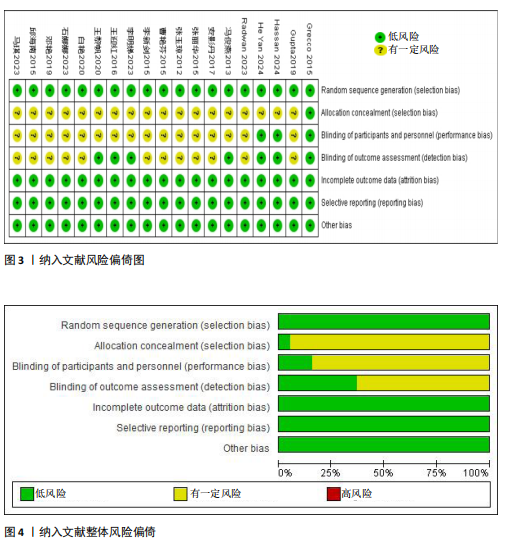
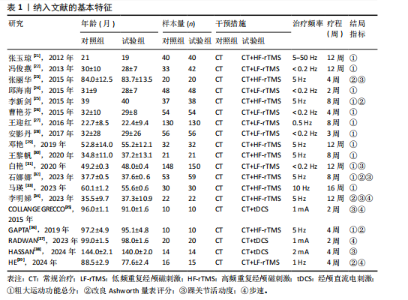
2.5 异质性分析 由于此次研究中粗大运动功能总分、改良Ashworth量表评分与踝关节活动度结局指标的异质性较大,故采用亚组分析及敏感性分析探讨异质性来源。 2.5.1 粗大运动功能评分 通过逐一剔除法进行敏感性分析,排除白艳等[31]研究后I2由96%下降为59%,结果显示试验组与对照组粗大运动功能评分比较差异有显著性意义[MD=7.17,95%(6.16,8.18),P < 0.001],见表2。由于结果仍存在一定异质性,故采用亚组分析进一步探讨异质性来源,结果显示年龄> 36个月和疗程≤4周的亚组I2 < 50%,不存在异质性,试验组与对照组粗大运动功能评分比较差异有显著性意义[MD=9.52,95%(6.70,12.33),P < 0.001;MD=8.01,95%(7.04,8.98),P < 0.001],见表3,提示年龄和疗程可能是异质性显著的原因。 2.5.2 改良Ashworth量表评分 逐一剔除法结果显示,剔除石娜娜等[32]研究后I2由97%将为0%,试验组与对照组改良Ashworth量表评分比较差异有显著性意义[MD=-0.26,95%(-0.49,-0.03),P=0.03];依次剔除其他研究后I2稳定在97%,P < 0.05,说明改良Ashworth量表评分敏感性分析结果较稳健,见表2。对比各项研究发现,石娜娜等[32]研究对照组干预措施采用穴位注射乙酰谷酰胺,其他研究均采用康复训练、物理因子疗法等康复技术,提示对照组干预措施的不同可能是异质性来源。 2.5.3 踝关节活动度 由于该指标的纳入研究较少,不宜进行亚组分析,故采用逐一剔除法分析异质性来源。结果显示,分别剔除白艳等[31]、石娜娜等[32]研究后I2均由92%下降为83%,试验组与对照组踝关节活动度比较差异有显著性意义[MD=2.65,95%(1.11,4.19),P < 0.001;MD=2.34,95%(0.82,3.87),P=0.003];依次剔除其他研究后I2稳定在91%-93%,P < 0.001,提示结果较稳健,见表2。对比各项研究发现,白艳等[31]研究样本量(298例患者)与其他研究(20-112例患者)存在较大差异,石娜娜等[32]研究对照组干预措施与其他研究不同。综上,提示样本量和对照组干预措施可能为异质性来源。 2.6 网状Meta分析结果 2.6.1 网状关系图 各结局指标的证据关系见图9,图中直线表示进行直接比较的研究,线段粗细表示直接比较的研究数,圆点表示干预措施,圆点大小表示采用该干预措施的样本量。由此次研究的网状关系图不存在三角形闭环,因此,无需进行不一致性检验。 2.6.2 两两比较结果 粗大运动功能总分:共纳入13项研究[21-22,24-33,36],涉及常规治疗、常规治疗+低频重复经颅磁刺激、常规治疗+高频重复经颅磁刺激3种治疗方案。结果显示,与常规治疗相比,常规治疗+低频重复经颅磁刺激可显著改善脑瘫患儿粗大运动功能[MD=11.01,95%CI(3.28,18.73),P < 0.05],其余组间比较差异无显著性意义(P > 0.05),见表4。 改良Ashworth量表评分:共纳入6项研究[23,25,32,34,36,39],涉及3种治疗方案,分别为常规治疗、常规治疗+低频重复经颅磁刺激、常规治疗+高频重复经颅磁刺激。结果显示组间两两比较差异均无显著性意义(P > 0.05),见表4。 踝关节活动度:共纳入6项研究[23,31-32,34-35,38],涉及常规治疗、常规治疗+低频重复经颅磁刺激,常规治疗+高频重复经颅磁刺激、常规治疗+经颅直流电刺激4种治疗方案。结果显示组间两两比较差异均有显著性意义(P < 0.05),见表4。 步速:共纳入4项研究[34-35,37,39],涉及4种治疗方案,分别为常规治疗、常规治疗+低频重复经颅磁刺激、常规治疗+高频重复经颅磁刺激、常规治疗+经颅直流电刺激。结果显示,与常规治疗相比,常规治疗+经颅直流电刺激[MD=0.21,95%CI (0.10,0.32),P < 0.05]、常规治疗+低频重复经颅磁刺激[MD=0.19,95%CI (0.09,0.29),P < 0.05]对提升步速有显著效"
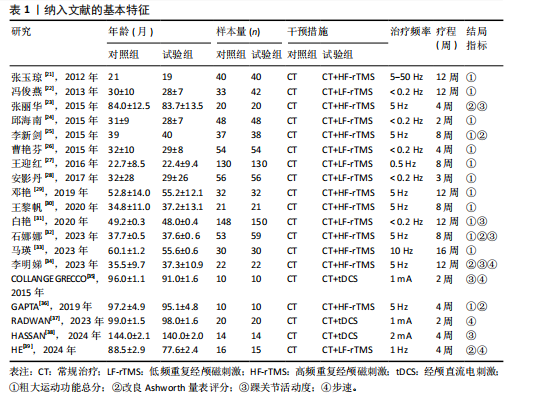

果(P < 0.05),其余组间比较差异无显著性意义(P > 0.05),见表4。 2.6.3 最佳概率排序结果 根据效应量及累积概率排序图数值可知:①粗大运动功能:低频重复经颅磁刺激(84.8%)> 高频重复经颅磁刺激(62.7%)> 常规治疗(2.5%),见图10A;②缓解痉挛:高频重复经颅磁刺激(77.8%)> 低频重复经颅磁刺激(47.8%)> 常规治疗(24.5%),见图10B;③踝关节活动度:经颅直流电刺激(77.8%)> 高频重复经颅磁刺激(64%)> 低频重复经颅磁刺激(44.6%)> 常规治疗(13.6%),见图10C;④步速:经颅直流电刺激(77.2%)> 低频重复经颅磁刺激(69.7%)> 高频重复经颅磁刺激(38.6%)> 常规治疗(14.3%),见图10D。 2.7 发表偏倚分析 由于改良Ashworth量表评分、踝关节活动度及步速3项结局指标的纳入研究较少,不宜进行发表偏倚分析,故对粗大运动功能总分进行发表偏倚评价。通过绘制比较-矫正漏斗图可知,漏斗图内散点分布不均且有部分研究落在范围之外,提示可能存在一定发表偏倚,见图11。Egger检验结果显示粗大运动功能总分的|t|=0.83、P=0.427,表明纳入的研究不存在小样本研究效应。 2.8 GRADE证据分级 GRADE软件显示,由于大部分研究未描述随机分组、分配隐藏和盲法方面,因此,评价局限性时均降1分;此外,GMFM总分、改良Ashworth量表评分、踝关节活动度结局指标均存在较高异质性,评价不一致性时降1分,具体结果见表5。"
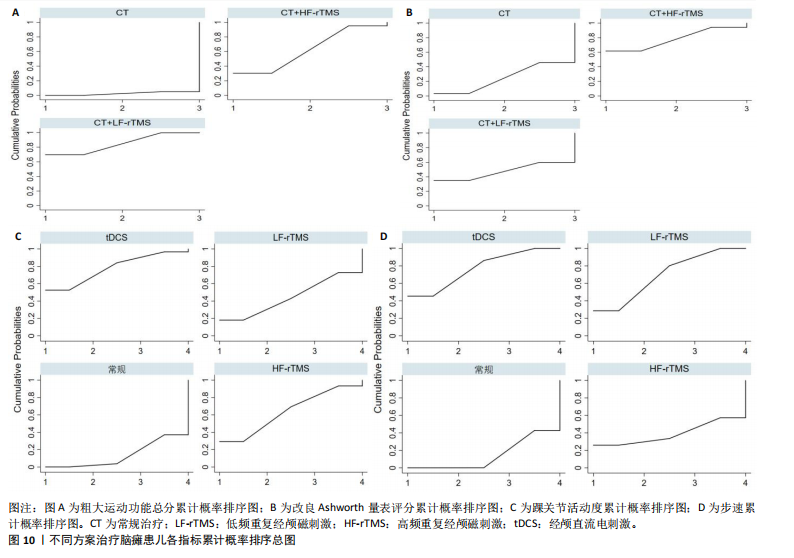
| [1] 中国康复医学会儿童康复专业委员会,中国残疾人康复协会,小儿脑性瘫痪康复专业委员会,等.中国脑性瘫痪康复指南(2022)第四章:康复治疗(上)[J].中华实用儿科临床杂志,2022,37(16): 1201-1229. [2] CHAGAS PSC, LEMO AG, AYUPE KMA, et al. Functioning profile and related impairments of children and adolescents with cerebral palsy-PartiCipa Brazil preliminary results. BMC Pediatr. 2024;24(1):719. [3] CARTON DE TA, HERMAN E, EBNER KD, et al. Hand-Arm Bimanual Intensive Therapy Including Lower Extremities in Infants With Unilateral Cerebral Palsy: A Randomized Clinical Trial. JAMA Netw Open. 2024;7(11):e2445133. [4] 中国康复医学会儿童康复专业委员会,中国残疾人康复协会小儿脑性瘫痪康复专业委员会,中国医师协会康复医师分会儿童康复专业委员会,等.中国脑性瘫痪康复指南(2022)第一章:概论[J].中华实用儿科临床杂志,2022,37(12):887-892. [5] LIU W, HU Y, LI J, et al. Effect of Virtual Reality on Balance Function in Children With Cerebral Palsy: A Systematic Review and Meta-analysis. Front Public Health. 2022;10:865474. [6] CRAIG BT, KINNEY LE, HILDERLEY AJ, et al. Structural connectivity of the sensorimotor network within the non-lesioned hemisphere of children with perinatal stroke. Sci Rep. 2022;12(1):3866. [7] NOVAK I, MORGAN C, ADDE L, et al. Early, Accurate Diagnosis and Early Intervention in Cerebral Palsy: Advances in Diagnosis and Treatment. JAMA Pediatr. 2017;171(9):919. [8] MARKS WA, HONERCUTT J, ACOSTA F, et al. Deep brain stimulation for pediatric movement disorders. Semin Pediatric Neurol. 2009;16:90-98. [9] LEE H, CHOI BJ, KANG N. Non-invasive brain stimulation enhances motor and cognitive performances during dual tasks in patients with Parkinson’s disease: a systematic review and meta-analysis. J Neuroeng Rehabil. 2024;21(1):205. [10] DORUK CD, KIRKOVSKI M, CROARKIN PE. Therapeutic Applications of Noninvasive Neuromodulation in Children and Adolescents. Psychiatr Clin North Am. 2018; 41(3):465-477. [11] ANTCZAK JM. Transcranial magnetic stimulation as a diagnostic and therapeutic tool in cerebral palsy. Postep Psychiatr Neurol. 2021;30(3):203-212. [12] TANG L, WU Y, MA J, et al. Application of tDCS in children with cerebral palsy: A mini review. Front Pediatr. 2022;10:966650. [13] ZHANG Q, QIU Z. Therapeutic effects of repetitive transcranial magnetic stimulation in patients with cerebral palsy: a systematic review and network meta-analysis. Neurol Sci. 2024;45(5):1953-1967. [14] SALEEM GT, CRASTA JE,SLOMINE BS, et al. Transcranial Direct Current Stimulation in Pediatric Motor Disorders: A Systematic Review and Meta-analysis. Arch Phys Med Rehabil. 2019;100(4):724-738. [15] ROBAINA-CASTELLANOS GR, RIESGO-RODRIGUEZ S, ROBAINA-CASTELLANOS MS.Definition and classification of cerebral palsy: a problem that has already been solved? Rev Neurol. 2007;45(2):110-117. [16] 唐久来,秦炯,邹丽萍,等.中国脑性瘫痪康复指南(2015):第一部分[J].中国康复医学杂志,2015,30(7):747-754. [17] NOVAK I, MORGAN C, FAHEY M, et al. State of the Evidence Traffic Lights 2019: Systematic Review of Interventions for Preventing and Treating Children with Cerebral Palsy. Curr Neurol Neurosci Rep. 2020;20(2):3. [18] 刘津池,刘畅,华成舸.随机对照试验偏倚风险评价工具RoB2(2019修订版)解读[J].中国循证医学杂志,2021,21(6): 737-744. [19] CUMPSTON M, LI T, PAGE MJ, et al. Updated guidance for trusted systematic reviews: a new edition of the Cochrane Handbook for Systematic Reviews of Interventions. Cochrane Database Syst Rev. 2019;10(10):ED000142. [20] DZIRI C. Evaluation of heterogeneity in meta-analysis. Colorectal Dis. 2023;25(5): 1037-1038. [21] 张玉琼,丁建英.经颅磁刺激对脑性瘫痪患儿粗大运动功能的影响[J].中国康复理论与实践,2012,18(6):515-517. [22] 冯俊燕,贾飞勇,姜慧轶,等.超低频经颅磁刺激对痉挛型脑瘫患儿运动功能的影响[J].中国当代儿科杂志,2013, 15(3):187-191. [23] 张丽华,郄淑燕,张黎明,等.重复经颅磁刺激对痉挛型脑瘫患儿痉挛及运动功能的影响[J].中国康复,2015,30(3):171-173. [24] 邱海南.超低频经颅磁刺激结合综合康复改善脑瘫患儿粗大运动功能[J].神经损伤与功能重建,2015,10(4):364-365. [25] 李新剑,仇爱珍,金鑫,等.重复经颅磁刺激联合康复训练治疗对促进脑瘫患儿运动功能发育与智力提高的作用[J].中国实用神经疾病杂志,2015,18(23):17-19. [26] 曹艳芬.ILF-TMS结合针刺对脑瘫患儿粗大运动功能的疗效观察[J].热带医学杂志,2015,15(11):1507-1510. [27] 王迎红,周正.重复经颅磁刺激对脑性瘫痪并发癫痫患儿运动功能的影响[J].中国康复理论与实践,2016,22(1):98-102. [28] 安影丹,任战领.超低频经颅磁刺激结合脑涨落图治疗对脑瘫患儿粗大运动功能的影响[J].神经损伤与功能重建,2017, 12(5):459-460. [29] 邓艳,曹明辉,张美萍,等.经颅磁刺激配合肌力训练改善脑瘫患儿认知和运动功能的研究[J].中国妇幼健康研究,2019, 30(1):15-18. [30] 王黎帆,刘建军,张雁,等.重复经颅磁刺激治疗脑瘫患儿的疗效观察[J].中国康复,2020,35(2):91-94. [31] 白艳,王秀霞,陈海英.经颅磁刺激联合核心肌力训练在痉挛型脑瘫患儿中的应用研究[J].中国全科医学,2020,23(2): 177-182. [32] 石娜娜,闻春波,霍艳飞,等.经颅磁刺激联合乙酰谷酰胺在脑瘫患儿康复治疗中的应用效果分析[J].实用医院临床杂志,2023,20(3):67-70. [33] 马瑛,赵明光,戴明,等.重复经颅磁刺激联合康复训练对脑性瘫痪患儿运动功能及认知功能影响研究[J]. 创伤与急危重病医学,2023,11(1):35-38,42. [34] 李明娣,梁冠军,张大力,等.重复性经颅磁刺激联合局部振动治疗偏瘫型脑性瘫痪儿童疗效研究[J]. 康复学报, 2023,33(6):515-520. [35] COLLANGE GRECCO LA, DE ALMEIDA CARVALHO DUARTE N, MENDONÇA ME, et al. Effects of anodal transcranial direct current stimulation combined with virtual reality for improving gait in children with spastic diparetic cerebral palsy: a pilot, randomized, controlled, double-blind, clinical trial. Clin Rehabil. 2015;29(12):1212-1223. [36] GAPTA M, RAJAK BL, BHATIA D, et al. Effect of repetitive transcranial magnetic stimulation on motor function and spasticity in spastic cerebral palsy. Int J Biomed Eng Technol. 2019;31(4):365-374. [37] RADWAN A, ELTALAWY HA, ABDELZIEM FH, et al. Effect of Transcranial Direct Current Stimulation versus Virtual Reality on Gait for Children with Bilateral Spastic Cerebral Palsy: A Randomized Clinical Trial. Children (Basel). 2023;10(2):222. [38] HASSAN Z, HADIAN MR, HUSSAIN SA, et al.Comparison of the Conjunct Effects of Electrical Stimulation and Whole-Body Vibration Therapy with Transcranial Direct Current Stimulation and Whole-body Vibration Therapy on Balance and Function in Children With Spastic Cerebral Palsy. Cureus. 2024;16(6):e61511. [39] HE Y, ZHANG Q, MA TT, et al. Effect of repetitive transcranial magnetic stimulation-assisted training on lower limb motor function in children with hemiplegic cerebral palsy. BMC Pediatr. 2024;24(1):136. [40] BRUNONI AR, CROARKIN PE,RAZZA LB. Emerging Trends in Non-Invasive Brain Stimulation: The New Kids on the Block. Biomedicines. 2024;13(1):14. [41] 陈桐彬,王佩佩,林晓燕,等.不同模式重复经颅磁刺激对脑卒中后认知障碍患者疗效的meta分析[J]. 中国康复医学杂志,2024,39(10):1519-1526. [42] FACCIOLI S, CAVALAGLI A, FALOCCI N, et al. Gait analysis patterns and rehabilitative interventions to improve gait in persons with hereditary spastic paraplegia: a systematic review and meta-analysis. Front Neurol. 2023;14:1256392. [43] 周正荣,王红,周佳佳,等.经颅磁刺激和经颅直流电刺激治疗孤独症谱系障碍的研究进展[J].神经损伤与功能重建, 2024,19(10):605-609. [44] MARKOWSKA A, TARNACKA B. Molecular Changes in the Ischemic Brain as Non-Invasive Brain Stimulation Targets-TMS and tDCS Mechanisms, Therapeutic Challenges, and Combination Therapies. Biomedicines. 2024;12(7):1560. [45] CHEN SY, TSOU MH, CHEN KY, et al. Impact of repetitive transcranial magnetic stimulation on cortical activity: a systematic review and meta-analysis utilizing functional near-infrared spectroscopy evaluation. J Neuroeng Rehabil. 2024;21(1):108. [46] PELLETIER SJ, CICCHETTI F. Cellular and molecular mechanisms of action of transcranial direct current stimulation: evidence from in vitro and in vivo models. Int J Neuropsychopharmacol. 2014;18(2):pyu047. [47] MALEKAHMAD M, FRAZER A, ZOGHI M,et al. Transcranial pulsed current stimulation: A scoping review of the current literature on scope, nature, underlying mechanisms, and gaps. Psychophysiology. 2024;61(3):e14521. [48] SHEN QR,HU MT, FENG W, et al. Narrative Review of Noninvasive Brain Stimulation in Stroke Rehabilitation. Med Sci Monit. 2022;28:e938298. [49] SAFDAR A, SMITH MC, BYBIOW WD, et al. Applications of Repetitive Transcranial Magnetic Stimulation to Improve Upper Limb Motor Performance After Stroke: A Systematic Review. Neurorehabil Neural Repair. 2023;37(11-12):837-849. [50] 柯嘉洽,邹晓佩,王春燕,等.经颅直流电刺激和经颅磁刺激在脑卒中上肢运动功能恢复的应用进展[J]. 中国神经精神疾病杂志,2021,47(1):50-55. [51] 李国华,陆艺,王胜秋.不同频率重复经颅磁刺激治疗脑梗死后失语症的疗效[J].山东大学学报(医学版),2023,61(7):83-89. [52] HONG A, ZHENG H, LUO J, et al. Effects of Low-Frequency Repetitive Transcranial Magnetic Stimulation on Language Recovery in Poststroke Survivors With Aphasia: An Updated Meta-analysis. Neurorehabil Neural Repair. 2021;35(8):680-691. [53] 任露,高畅,沈小雨.重复经颅磁刺激联合脑循环治疗仪对痉挛型脑瘫患儿全身运动功能、脑血流动力学的影响[J].中国康复,2023,38(3):153-158. [54] LONGO V, BARBATI SA, RE A, et al. Transcranial Direct Current Stimulation Enhances Neuroplasticity and Accelerates Motor Recovery in a Stroke Mouse Model. Stroke. 2022;53(5):1746-1758. [55] HAMEED MQ, DHAMNE SC, GERSNER R, et al. Transcranial Magneticand Direct Current Stimulation in Children. Curr Neurol Neurosci Rep. 2017;17(2):11. [56] ROUNIS E, HUANG YZ. Theta burst stimulation in humans: a need for better understanding effects of brain stimulation in health and disease. Exp Brain Res. 2020; 238(7-8):1707-1714. [57] LONG H, WANG H, ZHAO C, et al. Effects of combining high- and low-frequency repetitive transcranial magnetic stimulation on upper limb hemiparesis in the early phase of stroke. Restor. Neurol. Neurosci. 2018;36:21-30. [58] PETRUSEVIVIENE L, SACK AT, KUBILIUS R, et al. High-Frequency Ipsilesional versus Low-Frequency Contralesional Transcranial Magnetic Stimulation after Stroke: Differential Effects on Ipsilesional Upper Extremity Motor Recovery. Medicina (Kaunas). 2023;59(11):1955. [59] O’LEARY GH, JENKINS DD, COKER BP, et al. From adults to pediatrics: A review noninvasive brain stimulation (NIBS) to facilitate recovery from brain injury. Prog Brain Res. 2021;264:287-322. [60] 吴野,巩尊科,李新剑,等.不同模式经颅磁刺激对痉挛型偏瘫脑性瘫痪患儿上肢运动功能的影响[J]. 中国康复医学杂志,2019,34(11):1368-1370. [61] ELBANNA ST, ELSHENNAWY S, AYAD MN. Noninvasive Brain Stimulation for Rehabilitation of Pediatric Motor Disorders Following Brain Injury: Systematic Review of Randomized Controlled Trials. Arch Phys Med Rehabil. 2019;100(10):1945-1963. [62] FAN J, FU H, XIE X, et al. The effectiveness and safety of repetitive transcranial magnetic stimulation on spasticity after upper motor neuron injury: A systematic review and meta-analysis. Front Neural Circuits. 2022;16:973561. [63] WANG L, ZHU QX, ZHONG MH, et al. Effects of corticospinal tract integrity on upper limb motor function recovery in stroke patients treated with repetitive transcranial magnetic stimulation. J Integr Neurosci. 2022;21(2):50. [64] VALLE AC, DIONISIO K, PITSKEI NB, et al. Low and high frequency repetitive transcranial magnetic stimulation for the treatment of spasticity. Dev Med Child Neurol. 2007; 49(7):534-538. [65] VALLINOJA J, NUEMI T, JAATELA J, et al. Functional connectivity of sensorimotor network is enhanced in spastic diplegic cerebral palsy: A multimodal study using fMRI and MEG. Clin Neurophysiol. 2024;157:4-14. [66] AZIZI S, IRANI A, SHAHRIKHI A, et al. Contribution of altered corticospinal microstructure to gait impairment in children with cerebral palsy. Clin Neurophysiol. 2021;132(9):2211-2221. [67] DADGAR H, MAJIDI H, AGHAEI S. Biological and Neurobiological Mechanisms of Transcranial Direct Current Stimulation. Iran J Psychiatry. 2022;17(3):350-355. [68] BEHRANGRAD S, ZOGHI M, KIDGELL D, et al. The effects of concurrent bilateral anodal tDCS of primary motor cortex and cerebellum on corticospinal excitability: a randomized, double-blind sham-controlled study. Brain Struct Funct. 2022;227(7): 2395-2408. [69] DUMONT AJL, CIMOLIN V, PARREIRA RB, et al. Effects of Transcranial Direct Current Stimulation Combined with Treadmill Training on Kinematics and Spatiotemporal Gait Variables in Stroke Survivors: A Randomized, Triple-Blind, Sham-Controlled Study. Brain Sci. 2022;13(1):11. [70] CHRISTOPHER P, SUTTER EN, GAVIOLI M, et al. Safety, tolerability and feasibility of remotely-instructed home-based transcranial direct current stimulation in children with cerebral palsy. Brain Stimul. 2023;16(5):1325-1327. |
| [1] | Guo Ying, Tian Feng, Wang Chunfang. Potential drug targets for the treatment of rheumatoid arthritis: large sample analysis from European databases [J]. Chinese Journal of Tissue Engineering Research, 2026, 30(6): 1549-1557. |
| [2] | Leng Xiaoxuan, Zhao Yuxin, Liu Xihua. Effects of different neuromodulatory stimulation modalities on non-motor symptoms in Parkinson’s patients: a network meta-analysis [J]. Chinese Journal of Tissue Engineering Research, 2026, 30(5): 1282-1293. |
| [3] | Yang Zeyu, Zhi Liang, Wang Jia, Zhang Jingyi, Zhang Qingfang, Wang Yulong, Long Jianjun. A visualized analysis of research hotspots in high-frequency repetitive transcranial magnetic stimulation from the macroscopic perspective [J]. Chinese Journal of Tissue Engineering Research, 2026, 30(5): 1320-1330. |
| [4] | Yang Zhijie, Zhao Rui, Yang Haolin, Li Xiaoyun, Li Yangbo, Huang Jiachun, Lin Yanping, Wan Lei, HuangHongxing. Postmenopausal osteoporosis: predictive values of muscle mass, grip strength, and appendicular skeletal muscle index [J]. Chinese Journal of Tissue Engineering Research, 2026, 30(5): 1073-1080. |
| [5] | Fu Enhong, Yang Hang, Liang Cheng, Zhang Xiaogang, Zhang Yali, Jin Zhongmin. OpenSim-based prediction of lower-limb biomechanical behavior in adolescents with plantarflexor weakness [J]. Chinese Journal of Tissue Engineering Research, 2025, 29(9): 1789-1795. |
| [6] | Tian Jinxin, Zhao Yuxin, Hu Tong, Cui Tiantian, Ma Lihong. Effects of different transcranial magnetic stimulation modes on refractory depression in adults: a network meta-analysis [J]. Chinese Journal of Tissue Engineering Research, 2025, 29(35): 7639-7648. |
| [7] | Yuan Yingjia, Yi Yanzi, Li Jin, Wang Ke, Wang Yu, Lin Tianye, Zhang Qingwen, He Wei, Wei Qiushi. Effect of hip abductor muscle exercise on three-dimensional gait and collapse rate in patients with non-traumatic femoral head necrosis [J]. Chinese Journal of Tissue Engineering Research, 2025, 29(33): 7211-7216. |
| [8] | Zhang Jian, Cai Feng, Li Tingwen, Ren Pengbo. Fatigue gait recognition of athletes based on fish swarm algorithm [J]. Chinese Journal of Tissue Engineering Research, 2025, 29(30): 6489-6498. |
| [9] | Wang He, Yu Shaohong, . Meta-analysis of transcranial direct current stimulation in improving lower limb motor dysfunction in stroke patients [J]. Chinese Journal of Tissue Engineering Research, 2025, 29(30): 6556-6565. |
| [10] | Gou Yanyun, Hou Meijin, Jiang Zheng, Chen Shaoqing, Chen Xiang, Gao Yuzhan, Wang Xiangbin. Biomechanical characteristics of walking in patients with idiopathic scoliosis: cross-sectional analysis of three-dimensional motion capture [J]. Chinese Journal of Tissue Engineering Research, 2025, 29(3): 471-477. |
| [11] | Zheng Xiang, Zhang Mingxing, Huang Ya, Shan Sharui. Improvement of lower limb walking function in patients with chronic non-specific low back pain by biofeedback assisted electrical stimulation [J]. Chinese Journal of Tissue Engineering Research, 2025, 29(3): 547-553. |
| [12] | Li Yongjie, Liu Mengling, Zhang Dakuan, Fu Shenyu, Liu Hongju. Effect of unilateral knee osteoarthritis on gait dynamics and muscle activation asymmetry in elderly women [J]. Chinese Journal of Tissue Engineering Research, 2025, 29(27): 5750-5756. |
| [13] | Liu Yuhang, Li Hongyu, Wang Yong, Wang Fengxing. Visual analysis of application of three-dimensional finite element method in femoral head necrosis [J]. Chinese Journal of Tissue Engineering Research, 2025, 29(27): 5933-5940. |
| [14] | Zhang Yilong, Wu Wanling, Yang Wenwu, Wu Hongtao, Liu Wengang, He Minyi, Zhao Chuanxi. Correlation between preoperative knee extensor and flexor muscle strength and postoperative gait function in total knee arthroplasty [J]. Chinese Journal of Tissue Engineering Research, 2025, 29(27): 5819-5825. |
| [15] | Shaban Amiri Nzelekela, Yang Lianbo, Li Peng. Objective accuracy of six degree of freedom gait analysis system in evaluating the severity of knee osteoarthritis [J]. Chinese Journal of Tissue Engineering Research, 2025, 29(27): 5890-5896. |
| Viewed | ||||||
|
Full text |
|
|||||
|
Abstract |
|
|||||

